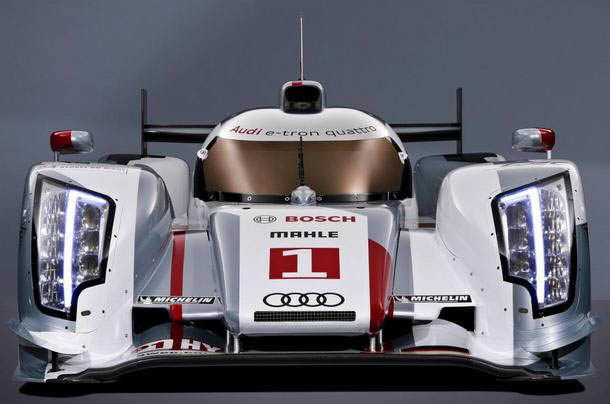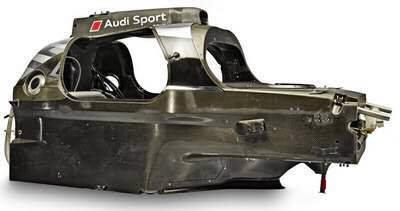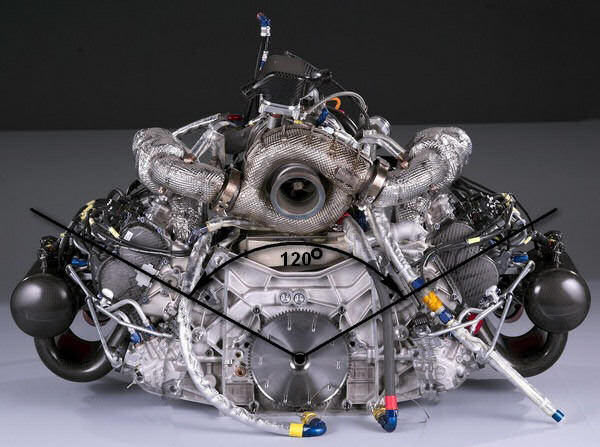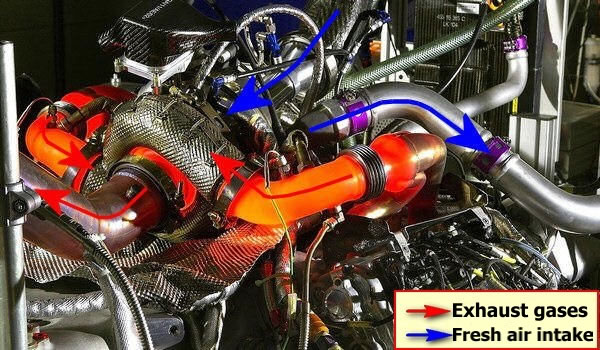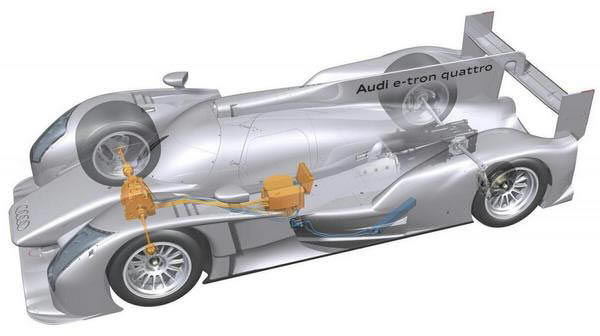Audi R18 e-tron Quattro
Flywheel KERS Hybrid System (2012)

From 16th to 17th June 2012, the 24 hours of Le Mans has taken place at the Circuit de la Sarthe for the 80th time, and again Audi didn’t mind pushing the envelope a little further than most people would and has proven that with the release of a new Le Mans race car. Audi has captured all three spots on the podium thanks in part to its diesel-hybrid R18 e-tron Quattro race cars. This marks the first time in the race's illustrious history that a hybrid has come out on top of the pack.
That doesn't mean that Audi was in a class of its own. During the first part of the race the they faced stiff competition from Toyota's gasoline-hybrid TS030 Hybrid powered by a non-turbo or compressed version of its 3.4 L V8 helped with a supercapacitor energy storage system developed by Nisshinbo. One of them even took the lead of the race at about 8pm on Saturday night but a series of crashes and mechanical failures ended up sending the Toyotas to the paddock for good. On the end, the first two spots went to the R18 e-tron while third and fifth went to the R18 Ultra, a non-hybrid variant of the car. The winning Audi lapped the Le Mans track 378 times.
"This is no doubt a historic victory for Audi," said Dr. Wolfgang Ullrich, the head of Audi Motorsports. "We were the first to win Le Mans with a direct-injection turbo gasoline engine and the first to be successful with a diesel engine. It’s a great result that Audi is now the first brand to have achieved victory with a hybrid vehicle."
As far as racing, Audi won 10 out of the last 12 races at Le Mans, conceding the 2003 victory to Bentley that anyhow stayed in then family. This is a particularly amazing record considering the 24 hour race of Le Mans is grueling and extremely unforgiving. How many cars have we seen lead at twilight only to witness their demise from the slightest problem.
And how all this started?
A significant reduction of the displacement limits put additional emphasis on aerodynamic efficiency ahead of the 2011 season and prompted Audi to develop the first closed cockpit sports racer for over a decade. Named the R18 TDI, the technicians focused from the very beginning of the ‘R18’ project on a compact 3.7 liter V6 TDI with innovative architecture. R18 TDI was still equipped with twin turbos, but with future in mind. The engineers left room in the design for future developments, including the adoption of a hybrid KERS drive system.
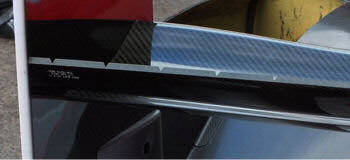 |
On the rear wing we can see this serrated gurney flap, with a V shapes cut into the edge. Cuts only appear on the outer edge of the gurney have some role in dealing with the dirty air from the front and rear wheels. |
For 2012, Audi introduced an evolution of the R18 TDI, last year Le Mans winner, called the R18 Ultra. In addition to the changes required by the regulations (reduced air intake restrictor and 60 litre fuel tank) the car was completely reworked to reduce weight. These changes included a completely new, fully carbon fiber gearbox housing (which is a first in endurance racing) and changes to the one piece improved monocoque (about 10cm longer then on R 18 TDI) making the ultra the lightest Le Mans prototype that Audi Sport has ever built. As for the closed cockpit, it’s there to give Audi a better chance and after R10, R15, and R18 TDI, the R18 Ultra has moved to a closed cockpit design again. A closed car has clear aerodynamical advantages. It’s not the first closed-cockpit Audi endurance racer though: in 1999 the company’s first entry into the Le Mans 24hrs included two R8C Coupes.
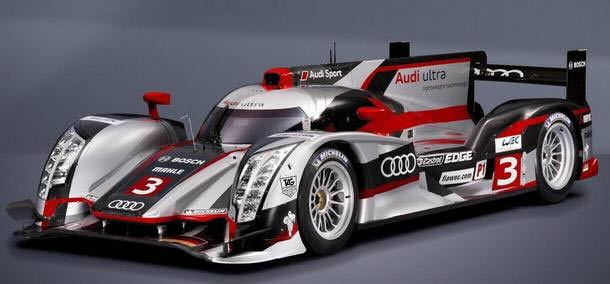 |
The R18 ultra is the basis that has made it possible to make the R18 e-tron quattro reality in the first place. |
One of the main reasons additional weight had to be shed was for the additional weight required for the hybrid system. Two versions of the evolution car were prepared; the 'conventional' R18 Ultra and the R18 e-tron Quattro equipped with KERS with two additional electric motors and a flywheel to store and distribute the generated energy. The base of both cars (undertray, monocoque, cockpit, body panels, and engine) is completely identical, which is why the additional logistical effort could be reduced for Audi Sport and Audi Sport Team Joest. The compact engine requires very little installation space, is light and plays its role in compensating for the hybrid system’s additional weight. In spite of the latest restrictions imposed by the Automobile Club de l’Ouest (ACO) and FIA, Audi Sport still extracts over 375kW (510 hp) and a maximum torque exceeding 850 Nm from the power unit thanks to the efficiency of the overall concept.
Work on the Audi R18 E-tron Quattro only started on February 2010 so Audi is being cautious. This is a relatively short cycle for a technology that has never been tested in motorsport and which still doesn’t even exist in production. So just to cover itself, Audi entered the 2012 Le Mans 24hrs field with two R18 E-tron Quattro’s, but also two 2012-spec (and non-hybrid) Audi R18 Ultras.
At first glance the R18 ultra or e-tron does not look much different to last year’s Le Mans winning R18 TDI. However, under the guidance of Head of Technology Dr. Martin Mühlmeier the Audi Sport engineers have done a great job and left hardly a single area of the car untouched. The result is a largely new LMP1 prototype – including a modified carbon-fiber monocoque, which continues to excel through its one piece construction. Despite the rigid structure of the monocoque, however, the drivers must pay close attention when entering and exiting the car. A small area marked by four red triangles is the only portion strong enough to bear the drivers' weight.
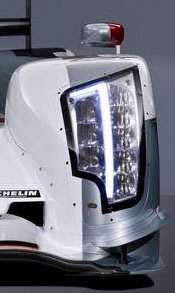 The extremely advanced aerodynamic configuration from 2011 was initially adapted to suit the new regulations, but later heavily modified. Production of new car demanded a further significant reduction in aerodynamic drag despite the increased cooling requirements for the hybrid components. Vision out of the closed cockpit was also improved. The engineers also improved the area illuminated by the full LED headlights in shape of number 1. Fundamentally, the hybrid drive, in combination with the four-wheel drive resulted in an extension of the front section of the monocoque. However, it also has positive effects on the overall balance of the conventionally powered twin brother. Because it is the lightest Le Mans Prototype that Audi Sport has ever built, engineers can position the additional ballast weight exactly where it is required for the races – even if both cars have exactly the same overall weight, 900 kilograms stipulated by the LMP1 regulations.
The extremely advanced aerodynamic configuration from 2011 was initially adapted to suit the new regulations, but later heavily modified. Production of new car demanded a further significant reduction in aerodynamic drag despite the increased cooling requirements for the hybrid components. Vision out of the closed cockpit was also improved. The engineers also improved the area illuminated by the full LED headlights in shape of number 1. Fundamentally, the hybrid drive, in combination with the four-wheel drive resulted in an extension of the front section of the monocoque. However, it also has positive effects on the overall balance of the conventionally powered twin brother. Because it is the lightest Le Mans Prototype that Audi Sport has ever built, engineers can position the additional ballast weight exactly where it is required for the races – even if both cars have exactly the same overall weight, 900 kilograms stipulated by the LMP1 regulations.
Both versions of the car sport a gearbox that features a complete carbon-fiber casing and has been the source of much of the weight saving. This kind of casing is a first in a Le Mans Prototype racing. The system is seen in Formula 1 cars, but in the R18 Le Mans prototype, the load borne by the structural transmission is much higher and has to last through 24-hour races that cover thousands of kilometers. Even the torque generated by the R18 e-tron Quattro exceeds the torque of an F1 engine, about 850 Nm, putting that much more stress on the lightweight design. This is mated to the wide-angle V6 with the single turbo-charger wedged between the cylinder banks.
Like the R10 and R15, the R18 is a diesel powered. But while the R10 had a 5.5-litre V12, and the R15 had a 5.5-litre V10, the engine in the new R18 is a 3.7-litre V6. The engine has been downsized to a V6 because of new regulations which aim to reduce CO2 emissions and overall fuel consumption by reducing the power and performance of these endurance racers.
Audi relies on a highly efficient engine concept in the R18. In an effort to increase the parity between the diesel and petrol powered machines, further restrictions were imposed on the diesel engines, lowering the V6's output to a claimed 510 bhp. The fact that the V6 3.7 TDI was voted “Race Engine of the Year 2011” by a high-caliber judging panel at the beginning of the year is a nice reward for the forward-thinking work of the entire team of engineers.
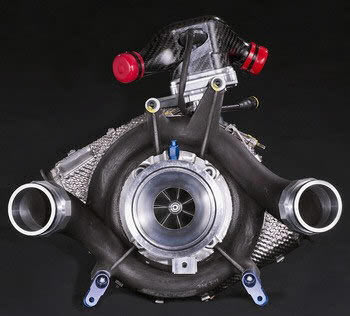 The interaction between the merely 3.7-liter V6 TDI unit with an unusually designed single turbocharger and VTG (Variable Turbine Geometry) technology is both complex and intriguing. TDI race engines provide a particularly striking example of the progress that has been achieved. In 2006, Audi won with a V12 engine which had 5.5 liters of displacement. Now, only six cylinders and 3.7 liters. This means that in total the engine used in the current car generation makes with half of the cylinders, has 32 percent less cubic capacity and in the 2012 season made it possible for the R18 to improve its lap time by 2.8 percent nonetheless. To achieve such increases the combustion chamber of the engine operates with much higher pressures and temperatures today than in the past. This has resulted in considerably higher performance of the piston areas and the cylinders. Now, each cylinder has to deliver around 60 percent more performance than it did in the Audi R10 TDI in 2006. Also, injection pressures which in current production engines rise to around 2,000 bar, in the Le Mans TDI engines are 2,600 bar are already being surpassed by far. This has a positive influence on fuel consumption, performance and exhaust gas quality, yet increases the thermal and mechanical loads particularly in the combustion chamber.
The interaction between the merely 3.7-liter V6 TDI unit with an unusually designed single turbocharger and VTG (Variable Turbine Geometry) technology is both complex and intriguing. TDI race engines provide a particularly striking example of the progress that has been achieved. In 2006, Audi won with a V12 engine which had 5.5 liters of displacement. Now, only six cylinders and 3.7 liters. This means that in total the engine used in the current car generation makes with half of the cylinders, has 32 percent less cubic capacity and in the 2012 season made it possible for the R18 to improve its lap time by 2.8 percent nonetheless. To achieve such increases the combustion chamber of the engine operates with much higher pressures and temperatures today than in the past. This has resulted in considerably higher performance of the piston areas and the cylinders. Now, each cylinder has to deliver around 60 percent more performance than it did in the Audi R10 TDI in 2006. Also, injection pressures which in current production engines rise to around 2,000 bar, in the Le Mans TDI engines are 2,600 bar are already being surpassed by far. This has a positive influence on fuel consumption, performance and exhaust gas quality, yet increases the thermal and mechanical loads particularly in the combustion chamber.
The charging concept of the Audi R18 has been a particularly well-kept secret up to now and is of radically new design. The engineers designed a central mono turbo system in the inside V of the engine which in combination with the inboard exhaust manifolds makes it particularly efficient. A single large turbine Garrett TR30R VGT (as opposed to the twin configuration of the previous Audi R18 TDI) increases overall efficiency, as gap losses are significantly reduced. Consolidating the entire exhaust flow in a single turbine leads to higher turbine performance and more uniform loading by exhaust gas surges. Clearly, less thermal energy is lost in the extremely short pipes of the exhaust system in front of the turbo. This increases performance plus the turbine’s exhaust gas temperature due to the higher energy content of the exhaust gas and makes the required capacity available on the compressor side where around 2,000 cubic meters of air per hour must be compressed for efficient combustion. The mono turbocharger thus has to put through a similar amount of charge air for over 375 kW (510 hp) as the two previous turbochargers in the V10 TDI for 404 kW (550 hp).
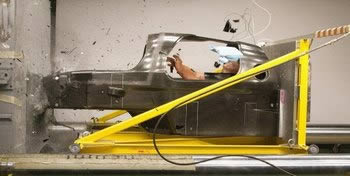 The exhaust manifolds located on the inside, between the banks of the engine, let the exhaust gas flow radially into the charger from both sides. The housing of the turbine wheel has two inlets for the exhaust gas flow and one axial outlet. The compressor side is of a very similar design. The charger aspirates air in axial direction from a central influx. After compression, the air exits again on two sides to optimally supply both cylinder banks. It is cooled down in two intercoolers before being routed to the combustion chambers of the V6 engine.
The exhaust manifolds located on the inside, between the banks of the engine, let the exhaust gas flow radially into the charger from both sides. The housing of the turbine wheel has two inlets for the exhaust gas flow and one axial outlet. The compressor side is of a very similar design. The charger aspirates air in axial direction from a central influx. After compression, the air exits again on two sides to optimally supply both cylinder banks. It is cooled down in two intercoolers before being routed to the combustion chambers of the V6 engine.
The variable turbine geometry of the turbocharger has provided another key to this technological breakthrough. It makes it possible to guide the exhaust gas flow in a way that the turbine can continuously be adjusted to varying operating conditions such as load changes. Without that the entire concept of a compact downsized engine with an inboard single turbocharger would have been inposible. Without VTG the response of a single, large charger would be far too low.
Turbocharger work at extreme temperatures of up to 1,050 degrees Celsius in the turbine and in the VTG can only be handled by high-temperature-resistant steel alloys. A technology that is heat-resistant and withstands large expansion must, conversely, not exhibit any increase in clearances when temperatures are low and all parts has to remain mobile at all times. These are exactly the technologies which Audi has developed together with its long-standing turbo partner Honeywell Garrett.
The two hybrid cars was driven by last year’s Le Mans winning trio of Marcel Fässler, André Lotterer, and Benoît Tréluyer, with Dindo Capello, Tom Kristensen, and Allan McNish in the other car. The R18 Ultra was driven by Loïc Duval joined by Timo Bernhard and Romain Dumas, with the other R18 Ultra driven by Marco Bonanomi, Oliver Jarvis and Mike Rockenfeller.
LMP1 Audi R18 e-tron Quattro
Technical Specifications for the Audi R18 e-tron Quattro (and Ultra)
Introduced: February 2012
Model: Audi R18 e-tron Quattro / Ultra
Vehicle type: Le Mans Prototype (LMP1)
Monocoque: Carbon-fiber composite with aluminum honeycomb monocoque (build by Dallara) with fully stressed engine, tested according to the strict FIA crash and safety standards.
Engine
Turbocharged 120° V6, Mid, longitudinally mounted, 4 valves per cylinder, DOHC, Single Garrett turbocharger, mandatory intake air restrictor of 1 x 45.8 mm diameter and turbo boost pressure limited to 2.8 bar absolute, diesel direct fuel injection, Fully stressed aluminum cylinder block and head, diesel particle filter
Fuel: Diesel
Engine management: Bosch MS24
Engine lubrication: Dry sump, Castrol
Displacement: 3,700 cc
Power: > 375 kW / 510 hp
Torque: > 850 Nm
BHP/Liter: >138 bhp / liter
Hybrid system
Type of accumulator: Electric flywheel accumulator, max 500 KJ, WHP (Williams Hybrid Power)
Motor Generator Unit (MGU): Bosh MGU on the front axle, water cooled with integrated power electronics, 2 x 101 bhp/75 kW
Drive: e-tron quattro All wheel drive
Drive/Transmission
Type of drive: Rear wheel drive, traction control (ASR), four-wheel drive e-tron Quattro from 120kmh
Clutch: Carbon clutch
Gearbox: Xtrac, Sequential, electrically activated 6-speed racing gearbox
Differential: Limited-slip rear differential
Gearbox housing: Carbon-fiber composite with titanium inserts
Driveshafts: Constant velocity sliding tripod universal joints
Steering/Suspension/Brakes
Steering: Electrical assisted rack and pinion steering
Front suspension: double wishbones, push-rod actuated torsion bar springs and fully adjustable dampers
Rear suspension: double wishbones, pull-rod actuated torsion bar springs and fully adjustable dampers
Brakes: Brembo, hydraulic dual circuit brake system, monobloc light alloy brake calipers, ventilated carbon ceramic disc brakes front and rear, infinitely manually adjustable front and rear brake balance.
Wheels: O.Z. magnesium forged wheels
Tires Michelin Radial, Front: 360/710-18, Rear: 370/710-18
Weight/Dimensions
Length: 4.64m
Width: 1.99m
Height: 1m
Minimum weight: 900 kg
Fuel tank capacity: 58 liter (e-tron)/60 liter
Sports prototype is where you will see the latest technologies thoroughly tested, which eventually trickle down to our every day cars. The Germans have done a great job fine tuning diesel over the past decade and the Audi R18 e-tron Quattro pushes the envelope further. It will go against other forms of electric motor hybrids with a flywheel.
The 24 Hours of Le Mans have seen its average speed go from 125 mph to now well north of 210. Audi’s V12, 5.5 liter 700 hp R10 TDI clocked in at 204 mph in the 2006 race. A year later it reached 211 mph.
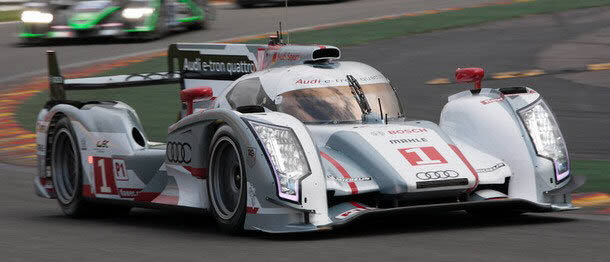 |
Both the Ultra and e-tron Quattro made their racing débuts at the 2012 6 Hours of Spa-Francorchamps in Belgium as part of a four-car Audi entry in the FIA World Endurance Championship, and after that it hit the 12-hour race at the US’ Sebring circuit. |
Both the Ultra and e-tron Quattro made their racing débuts at the 2012 6 Hours of Spa-Francorchamps as part of a four-car Audi entry in the FIA World Endurance Championship. The #3 car of Romain Dumas, Loïc Duval and Marc Gene gave the Ultra victory over the e-tron Quattro. Audi finished 1-2-3-4 in the race. Audi has entered a four car line-up for Le Mans but they intend to run one of each model for the remaining five races in the season. The e-tron Quattro finished first and second at the 24 Hours of Le Mans with the Ultra finishing in third and fifth. The leading car covered 5151.8 km, making 33 pit stops.
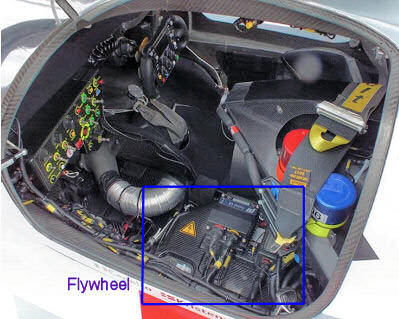 |
The energy is stored in an electric flywheel that is mounted alongside the driver. Supplied by Williams Hybrid Power, the flywheel spins in a vacuum at speeds of up to 45,000 rpm. |
As in other areas Audi Sport also cooperates with external manufacturers during the manufacture of components for the hybrid system. Instead of a heavy battery pack, R18 e-tron Quattro utilize a Williams Hybrid Power designed magnetic loaded composite flywheel accumulator system for energy storage which delivers 500 kJ to the front wheels via an electric motor, giving the car four (quattro) wheel drive. This system was originally designed for F1 by Williams Hybrid Power (similar design Porsche used with much success on their GT3 R hybrid between 2010 and 2011) and, as per the regulations, is only available at speeds above 120 km/h. The car is fitted with a smaller 58 litre fuel tank. WHP designed an entirely new, ultra-lightweight electric flywheel and associated power electronics for the Audi R18 e-tron Quattro, working closely with Audi engineers to fully integrate the system into the car. The key features and benefits of the WHP system are highly suited to endurance racing and this made the WHP flywheel the prime candidate for Audi’s project when compared to other technologies such as batteries, ultra-capacitors or mechanical flywheels. Design of the Motor Generator Unit (MGU) integrates two electric motors, two planetary transmissions and two converters, essentially the meat of the hybrid drive system, into a single compact package, and is designed by long-standing technology partner Bosch.
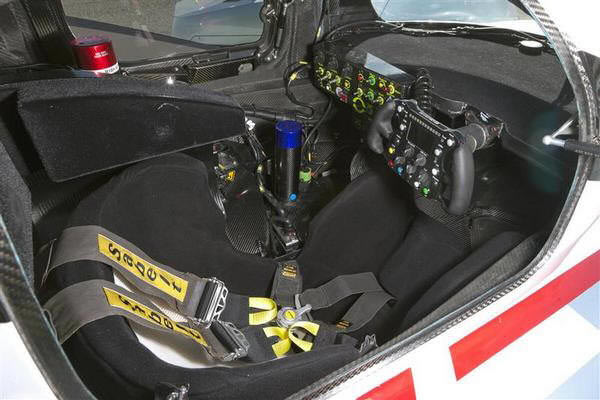
The rear wheels are driven by a 3.7-liter V6 TDI turbodiesel and do not get power from the hybrid system. The hybrid system provides 500 kilojoules of power in the front wheels when the flaywheel spin at full speed of 45,000 rpm (fully charged). The advantage of a flywheel system compared to other hybrid designs is that it is a high power density with low mass, high efficiency energy transfer system, and a long life cycle and wide temperature range. Compared to conventional batteries, a flywheel can be charged and de-charged quickly and also does not suffer from degradation.
The system integrated into the front axle is comprised of two driveshafts (one for each wheel of cours), the two Motor Generator Unit including planetary gears, an insulation monitoring unit for high voltage safety and the control system. The flywheel itself is housed in the passenger seat area of the cockpit which has been redesigned to improve visibility, with the side windows enlarged and the head restraints reworked. It was a question of perfectly balancing weight, performance, hybrid concept, regulation constraints and the packaging. The distribution of all the components in such a way that no appreciable disadvantages arise in the conventional vehicle since both cars are absolutely identical, with the exception of the hybrid system, in design and construction.
 |
Both cars are so identical that the front wheel driveshaft of the R18 hybrid means that a hole is required in the front of the chassis. This hole is present on both the hybrid and the combustion car though on the latter a blanking plate is used. |
Audi have stated that if needed one type of car could be converted in the other version without much effort. Both cars are so identical that the front wheel driveshaft of the R18 hybrid means that a hole is required in the front of the chassis. This hole is present on both the hybrid and the combustion car though on the latter a blanking plate is used. On combustion car, ballast is placed in the void left by the absent electric motor. There are some minor differences between the two cars including around the nose duct, where is a small interchangeable panel on the outside edge of the duct, which is probably related to cooling of the brakes, and in the case of the hybrid possibly the e-motor, although that is liquid cooled via a radiator in the left sidepod. On the hybrid car the shape of the duct is different and the aperture slightly larger. The modifications made to the front crash-structure in order to accommodate MGUs are also incorporated in the Ultra.
Suspension is more conventional with double wishbones all around. Push-rods are used at the front while the new rear-end features pull-rod actuated springs and dampers. Another novelty is a rear-view camera that is connected to a small screen in the cockpit and improves the drivers' rearward visibility.
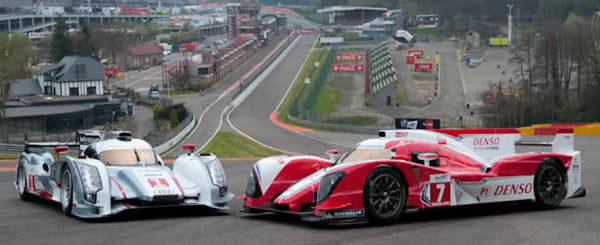 |
First two Hybrid LMP1 race cars, diesel Audi R18 e-tron quattro and Toyota's gasoline-hybrid TS 030. |
The hybrid systems of Audi and Toyota recover the energy generated under braking. Previously this was lost; it is now stored and transmitted under acceleration. In order to limit the size of these systems and the budgets required for their development, the ACO and the FIA have imposed a maximum quantity of energy that can be transmitted between two braking phases: 500 kilojoules. Each hybrid car can take advantage of additional electric power without exceeding the minimal aid down in the technical regulations.
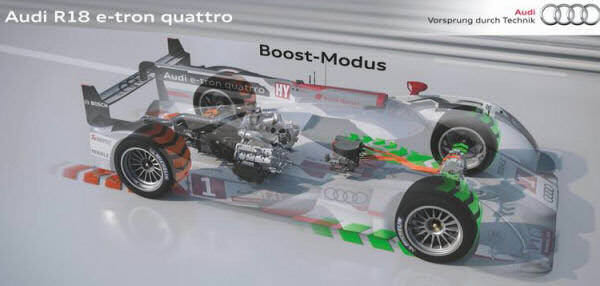
The process of energy recuperation is explained relatively easily, the technical implementation is, in contrast, extremely challenging. The recuperation of energy occurs only during braking. In the process, the wheels drive the MGU (the braking zones permitted are defined by the regulations). The MGU, now as electric motor, electrically spins a carbon-fiber flywheel that runs in a highvacuum to 45.000 RPM. In this way kinetic energy is generated and stored in rotating flywheel. After the corner is taken and driver pushes the gas pedal, and above a speed of 120km/h, oposite happend. The flywheel delivers kinetic energy to MGU (now as generator unit) and spins it to generate electric power for electric motor that drive the front wheels, giving the car an acceleration boost. Following protests from a rivalling teams, it was decided that front motors could only be used at speeds of over 120 km/h. This removes most of the all-wheel drive benefits provided by the driven front wheels. For Toyota, on the other hand, in which the energy is fed to the rear drive train there is no minimum speed.
The planetary gears adapt the transmission ratio of both driveshaft of the MGU during acceleration and braking. The two independently powered front axles on the e-tron Quattro are synchronized exclusively via electronic control strategies. This control occurs automatically without driver intervention. The entire charging process (recuperation, harvesting) is controlled by two parameters: the braking process and the flywheel accumulator’s state of charge (actualy speed of it, fully charged = 45.000 RPM). The energy emission process (boost) is defined by the minimum speed of 120km/h stipulated by the regulations, the race strategy selected, the throttle pedal movement and acceleration of the car. The e-tron has six automatic modes that are driver selectable on the steering wheel. The modes manage engine mapping, short bursts accelerating from corners, quattro four wheel drive, wet weather, etc. Allan McNish said "I don't have to press a button ... It does it automatically ... It is like traction control."
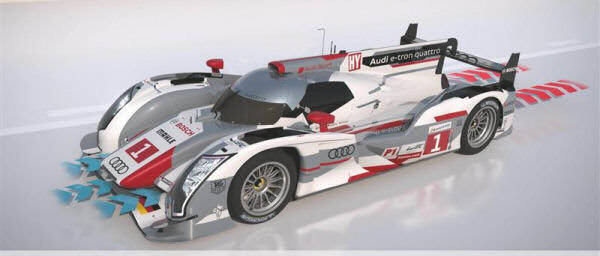
To cool the electric motors and the flywheel an additional cooling system is fitted in left sidepod, which is responsible for a slight increase in weight and drag compared to the conventional R18 Ultra.
In order to establish clearly-defined hybrid zones, those allowing energy to be transmitted between two braking phases, the Automobile Club de l’Ouest and the FIA have defined the zones where braking is sufficiently heavy to be taken into account, for every circuit during racing season. There were five on the Spa-Francorchamps circuit in the second round of the FIA World Endurance Championship on 5th May 2012 in which this system was used for the first time. On the 13,629-km Le Mans circuit there were seven zones.
Zone no. 1: Dunlop chicane (no. 8 marshal’s post)
Zone no. 2: Forza Motorsport Chicane (no. 42 marshals’ post)
Zone no. 3: Michelin Chicane (no. 60 marshals’ post)
Zone no. 4: Mulsanne corner (no. 76 marshals’ post)
Zone no. 5: Indianapolis Corner (no. 96 marshals’ post)
Zone no. 6: Porsche Corner (no. 115b marshals’ post)
Zone no. 7: Ford Corner (no. 131 marshals’ post)
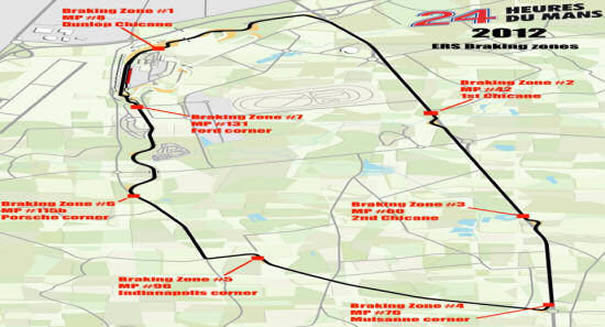
The entry to each zone is 50 meters before the corner in question. All entrants have to respect these zones.
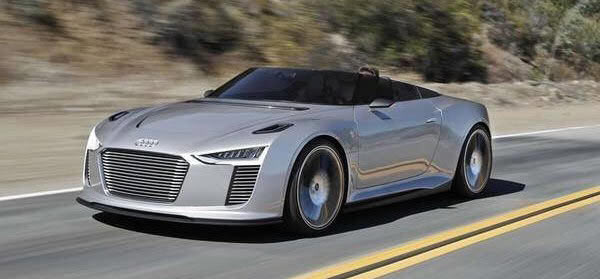 |
Audi presented the e-tron Spyder in January 2011 at the Las Vegas Consumer Electronics Show as $5 million concept car. Based on a shortened, widened, heavily modified R8 platform, the E-Tron Spyder mounts a 3.0-liter, 296 bhp turbo diesel behind the passenger compartment and two electric motors up front developing a total of 88 bhp. The lithium ion batteries are also located under that front hood, stowing a total of 9.6kWh of electricity. The car can run on either power source alone or combine them for some seriously impressive, and eco-friendly, acceleration. Though the diesel fuel tank carries just 50 liters, the e-tron Spyder has an on-paper range of more than 1,000 kilometers per fill-up thanks to its lithium-ion-fueled parallel help, which translates to just 2.2l of diesel/100 km. Limited top speed of 250 km/h, reaching 100 km/h from a standing start in just 4.4 seconds. |
September 17, 2012
Toyota's first World Endurance win with supercapacitor hybrid TS030 car
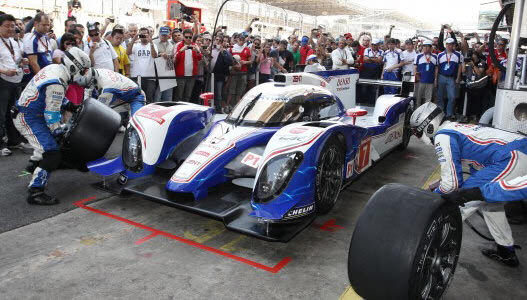
The battle of the hybrid racing cars in World Endurance Racing took an interesting turn this weekend when Toyota's TS030 Hybrid won the fifth round of the FIA World Endurance Championship in Sao Paulo, Brazil, Wurtz and Lapierre as a drivers. In Interlagos Toyota took pole by a whopping 0.784 second margin and led unchallenged for most of the first hour.
The TS030 Hybrid uses a petrol 3.4 litre V8 engine and, instead of battery, a Nisshinbo 500 kJ supercapacitor energy recovery unit which only feeds energy to the rear wheels via a Nippondenso drive unit. Toyota was not expected to seriously challenge the Audi R18 e-tron quattro for some time.
Many people believed the rear-wheel-drive Toyota system would prove to be inferior to the four-wheel-drive Audi design, but the speed of the TS030 has been very impressive, particularly in its second race at Silverstone on August 24 where it finished second to the Audi e-tron quattro but set the fastest lap of the event and had a higher top speed than the Audi.
The "Toyota Hybrid System - Racing" development project finally proved itself, and the race was a personal triumph for Hisatake Murata, who has headed the project since its inception 6 years ago, and is now Hybrid Project Leader at Toyota Racing. The project took its first win in July 2007 when a Toyota Supra became the first hybrid car to win a race at the Tokachi 24 Hour event in Japan that year. An early version of the TS030 supercapacitor hybrid system was used in the Supra.

